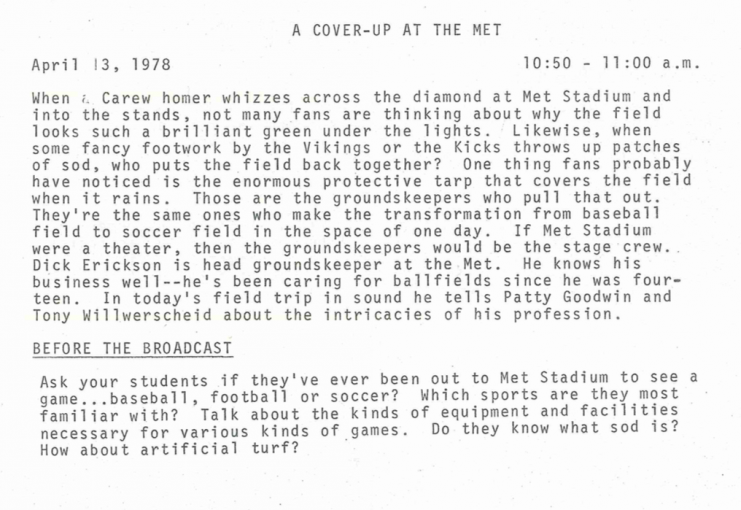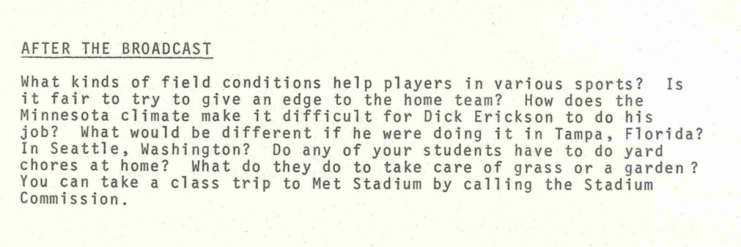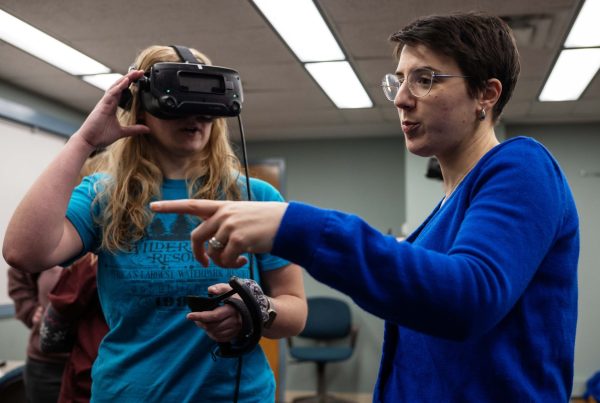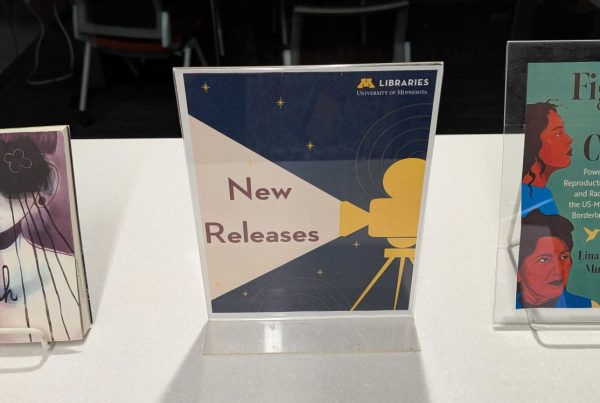You are listening to U of M Radio on your Historic Dial!
From 1938-1979, the Minnesota School of the Air brought educational programs into the classrooms of Minnesota and beyond over radio airwaves and through tape transcription. During the 1977-1978 season, School of the Air produced a series of radio “field trips” called Look What We Found, a program that introduced students to people and places in Minnesota. Join us this season as we revisit these radio field trips. Today’s episode takes listeners to Metropolitan Stadium to learn how to stay dry on a rainy day.
Season 2: Episode 6. A Cover-up at the Met.
Podcast (umnradio): Play in new window | Download
You are listening to U of M Radio on your Historic Dial podcast. Welcome to Season 2: Episode 5.
Hi, this is Rebecca from University Archives. The title for the April 13, 1978 broadcast of Look What We Found is “A Cover-up at the Met.” Met is a nickname for Metropolitan Stadium, the former home to Minnesota’s professional sports teams. The stadium opened in 1956 and was demolished in 1985. It’s where Harmon Killebrew hit home runs for the Twins, and where Fran Tarkenton threw touchdown passes for the Vikings. The Kicks, a professional soccer team, also played in the stadium from 1976-1981.
The introduction to this program in the Teacher’s Guide states, “When a Carew homer whizzes across the diamond at Met Stadium and into the stands, not many fans are thinking about why the field looks such a brilliant green under the lights. Likewise, when some fancy footwork by the Vikings or the Kicks throws up patches of sod, who puts the field back together? One thing fans probably have noticed is the enormous protective tarp that covers the field when it rains. Those are the groundskeepers who pull that out.”

Text from the “Look What We Found” teacher’s manual for the April 13, 1978 episode “A Cover-up at the Met.”
On today’s historic broadcast of Look What We Found, you’ll hear from Dick Erickson, the stadium supervisor at the Met. He described the difficulties of rearranging the field to accommodate three different professional sports.

After the broadcast questions from the “Look What We Found” teacher’s manual for the April 13, 1978 episode “A Cover-up at the Met.”
Metropolitan Stadium was built before Minnesota had any professional sports teams. In the 1950s, a Metropolitan Sports Area Commission was created to oversee the construction and operation of a stadium with the potential to accommodate professional teams. A local fundraising campaign was initiated to secure the funds. Farmland was purchased in the city of Bloomington, south of Minneapolis, as the site for the stadium.
On opening day, April 24, 1956, it was the Minneapolis Millers minor league baseball team that took to the field. However, Minnesotans only had to wait a few more years for professional teams to come. The Vikings played their opening game on September 17, 1961 and pulled off a victory against the Chicago Bears 37-13. The Twins lost their home opener on April 21, 1961 5-3.
Within a year after this program aired on KUOM, construction began on a new indoor domed stadium in downtown Minneapolis. The Kicks, Vikings, and Twins all played final games at Metropolitan Stadium in 1981.
The stadium was demolished in 1985 and the site was replaced by the Mall of America, which opened in 1992. A Metropolitan Stadium home plate marker was placed in the flooring of the mall’s amusement park to mark the spot of the original home plate.
Now, let’s travel back to the stadium in 1978 and listen to “A Cover-Up at the Met.”
Broadcast Transcript
[Music]
Various voices: I don’t believe it. Hahaha! Wow! Psyched out!
[Group exclamation] Look what we found!
Announcer: Come on you’ve been sitting there far too long. Join the Minnesota School of the Air as we take a field trip in sound to someplace you’ve probably never been, somewhere in and around the Twin Cities. And here to go with you are your hosts Walter, Patty, and Bill.
Walter: Bill, Bill, guess what I got? Tickets for the next Twins game right behind home plate.
Bill: No kidding. I haven’t been to Met stadium since the Twins played last summer.
Patty: I went out there last summer too and I brought my friend Tony Willwerscheid. We talked to Dick Erickson.
Walter: Is he a baseball player?
Patty: No… he’s the stadium supervisor.
Walter: Oh.
Patty: Which means he’s in charge of keeping up all the grounds. That’s what we talked about. Now, close your eyes – imagine it’s summer and you’re standing at home plate at Met Stadium. Stuart, roll the tape!
Patty: Right now it’s baseball season and as a matter of fact there’s a game today, right?
Dick: Uh, that’s right Patty.
Patty: And generally, what do you do ahead of time on the day before the game? What are the things that have to be done to get the field and the stadium in general ready?
Dick: Well, in general, we’re talking about the baseball field, we have to prepare the grass and the dirt area. Actually, the dirt area which looks easy is probably the hardest part of the stadium to keep up for baseball. In other words, you’re trying to make that so the ball will bounce right. And every day that has to be watered, uh, according to the weather, and watered heavy and try to get the moisture underneath it and dry on the top. So, when the ball is hit to the ballplayers it will come halfway in range of them and uh, not surprise them or go over their head.
Patty: Okay, how do you do that? You say that you’ve got to get the moisture underneath the dirt and it’s got to be the right amount of moisture… how do you gage the right amount of moisture and how do you get it underneath?
Dick: Well that’s, you have to go with the weather and if it is a clear day the only way you can get it underneath you have to soak it and you really really put water out there for it and it actually sits on the top for about a half inch. But you do this in the morning so you know let it soak down then by noon it gets dry on the top and then you’ll nail drag this. And you’ll dig it up maybe about a half inch to three-quarters of an inch and that dries the top of it and it also seals off the moisture underneath so at night it will still stay moist and the ball will bounce pretty true. That’s what we try for. Sometimes we can’t do it but we try it that way
Tony: When it rains out doesn’t the dirt on the mound kinda roll off and get lower?
Dick: Ah, when it rains, uh, on the mound… it’s a heavy clay so it really doesn’t wash off or get lower. It gets very slippery and very hard to play on. And then we try to, it’s actually when the umpire calls the game but it’s probably the mound he’s more concerned about because it gets so slippery and so we always try to protect it when it rains by putting a tarp on it and if it does get moist it really won’t wash off or get lower but it makes it very difficult to play on. Uh, the minute the umpires will call the game they will they usually will play a bit in the drizzle but the minute it comes down too hard they’ll take and call for the tarp and the tarp is out in right field, but when that tarp… it takes two minutes, about a minute and forty-five seconds to come in. And the meantime they will cover the mound and home plate by hand with some small tarp but the infield will be covered with a tarp that’s 180 feet by 180 feet so the whole field, infield area, will be covered.
Patty: Mr. Erickson doesn’t just take care of the field. In a certain way, he also takes care of the players.
Dick: Gene Mauch is our manager now who is probably the smartest manager in baseball. I know I worked with Gene when he was a ballplayer in St. Paul. He was playing shortstop for us then and um, he knows every little angle there is and there’s little tips he gives me. We had during the World Series in 1965… we had uh, the Los Angeles Dodgers and a very fast team. Maury Wills… remember that shortstop? Man, he could really run. Well, they came here and we won all of our games here and we went to Los Angeles and they kept their field very hard and they stole all kinds of bases against us and so when they come back here again they want to counteract so what we do in front of first base we took and put a wheelbarrow of sand and we dumped it right out there so when Maury Wills got ready to run he was in this loose sand that it’s just is like have you ever tried to run on the beach, it’s hard to run see. And that’s a way you can alter your field and that way you can… it it’s too loose it’s going to be slow. You know, and at the same time, if it’s hard, it could be fast for the runners and so you can kinda tailor that around for teams. It does backfire, and it doesn’t pay to do too much of it but you can always try to favor the home team. And generally, our field is one of the better fields in the league, but it takes a little bit longer so a lot of times they’ll say our field is terrible other times they’ll say it’s great and there won’t be consistent. In general, we try to keep it looking good… there is… sometime it isn’t as good as it looks but if they can win, you have a winning team usually everything is fine. This year we’re playing pretty good ball and the field is fairly good, but if they start losing, we have to take a little blame there too.
Tony: How do you rearrange this field… like… so it’s a baseball field and say there is a soccer game a couple days after this field is like this… how do you rearrange it and make it like…
Dick: Well it’s a good question. Course they all have their own rules going, and we more or less where the lines go and uh, if they have goal posts or uh, the Kicks they have the goalie’s box and things like that it’s just a matter of putting down the different lines and the trick of the thing is to try to use the right material so that so that you can kinda get it off. In other words, we won’t use a permanent paint on the field if it’s a baseball game in the afternoon and maybe a soccer game at night because it’s too hard to get the lines out. So, we’ll use probably a whiting that we can kinda wash off and it’s just a matter of… as you can see the fellas out there today are getting ready for football. Tomorrow afternoon we have a baseball game, tomorrow night we have a football game. That could be quite the task so they try to prepare a little bit ahead of time and right now they’re checking out the goal posts to make sure that they can get them up in time and because tomorrow they haven’t got time in case there is something wrong.
Tony: Um, say like would you take off the mound like cut it off or whatever and then uh, put sod around the running bases, so…
Dick: For the Kicks, when the Kicks play we do, we take the mound out. The mound is on a concrete pad and there is a steel plate underneath it and so we go out there and we have four winches and we can crank that mound right up and we’ll roll it off with four wheels, we’ll put it out over on the sidelines and then we lay down maybe a piece of plywood and will cover it with artificial turf and it’ll be… it won’t look the same as grass but it will be… it actually will have the Kicks emblem on it. For football we don’t really have to move the mound right away cause there’s just – it barely misses the mound and as far as the skin area we have to leave it dirt during the baseball season because you can’t put that grass in that quick but as soon as the baseball season is over then we’ll take all the skin area and we’ll start growing grass in there for to make it all look like a football field.
Patty: Is um, is the skin area the brown sections where the…
Dick: That’s right Patty…
Patty: Where the baserunners…
Dick: That’s what I call the skin area any of the dirt area and it’s, uh, on a 95-foot radius from the front of the mound and it’s also the base pass coming from home plate. All those areas are always sodded in for football.
Patty: Could you tell me a little bit specifically what you mean when you say this is one of the best fields in the league? What makes it the best or one of the best?
Dick: Well, uh, first of all, we have no budget here. We can spend anything we want to keep this field as good as we possibly can. Well, when you don’t have that handicap, in other words, you can put any amount of money into it. And so, in other words, your labor is no problem and I think one of the reasons why our field is one of the better ones is because we have a good crew that works on it. I have a good crew under me I can rely on them and they’re out there all the time and they have their heart in it and so they’re always trying to improve it and money wise we spend maybe a hundred… a hundred, 125,000 dollars if the weather is good, maybe 150,000 if the weather is real bad. And it’s… that’s just strictly with baseball, but even with football, it can go a lot higher if you are out there shoveling a lot of snow and it… and if the Vikings go into December and play way late in December that is when it gets quite costly because you’ve got to shovel all that snow off the field by hand and it takes a lot of men you might put maybe 100 men out there just shoveling snow, so that can get quite costly. Because you can’t really come out with heavy equipment because you have the tarps down and if you come out with a plow you’d just rip all the tarps up so you have to do… shovel that all by hand and that’s where your budget can really go high.
Bill: Patty, did Dick Erickson say he knew Gene Mauch when he played baseball for St. Paul?
Patty: Right. Erickson started his career of caring for ball fields in St. Paul when he was 14 years old. He goes back a long time in this business.
Walter: I guess the Twins, the Kicks, and the Vikings are lucky to have him.
Patty: Yes, they are.
Bill: Boy, we are about out of time.
Walter: Okay, goodbye!
Patty: Bye kids!
Bill: Later on!
[Music]Announcer: Producers for Look What We Found are Patty Goodwin, Bill Golfus, and Walter Brody. Join us next time for another field trip in sound brought to you by The Minnesota School of the Air.
[Music fades out]
About this podcast
The U of M Radio on Your Historic Dial podcast is produced by University Archives for your enjoyment. Subscribe or download on iTunes or GooglePlay so you don’t miss another moment of historic Minnesota radio.
Recordings of the program series Look What We Found were digitized in 2016 in part with funds provided by the State of Minnesota from the Arts and Cultural Heritage Fund through the Minnesota Historical Society.
—Rebecca Toov is the collections archivist for the University of Minnesota Archives.





